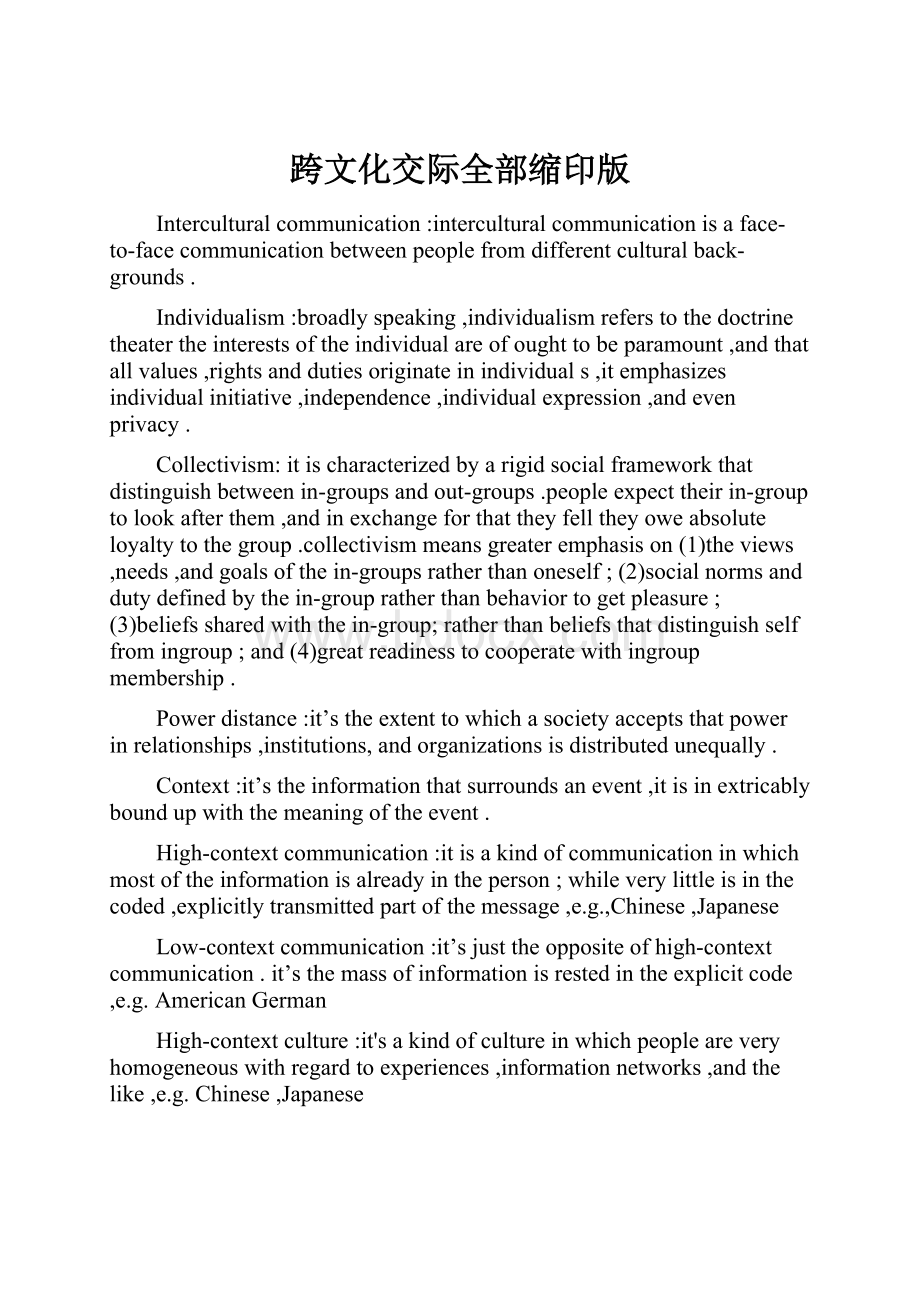跨文化交际全部缩印版.docx
《跨文化交际全部缩印版.docx》由会员分享,可在线阅读,更多相关《跨文化交际全部缩印版.docx(16页珍藏版)》请在冰豆网上搜索。

跨文化交际全部缩印版
Interculturalcommunication:
interculturalcommunicationisaface-to-facecommunicationbetweenpeoplefromdifferentculturalback-grounds.
Individualism:
broadlyspeaking,individualismreferstothedoctrinetheatertheinterestsoftheindividualareofoughttobeparamount,andthatallvalues,rightsanddutiesoriginateinindividuals,itemphasizesindividualinitiative,independence,individualexpression,andevenprivacy.
Collectivism:
itischaracterizedbyarigidsocialframeworkthatdistinguishbetweenin-groupsandout-groups.peopleexpecttheirin-grouptolookafterthem,andinexchangeforthattheyfelltheyoweabsoluteloyaltytothegroup.collectivismmeansgreateremphasison
(1)theviews,needs,andgoalsofthein-groupsratherthanoneself;
(2)socialnormsanddutydefinedbythein-groupratherthanbehaviortogetpleasure;(3)beliefssharedwiththein-group;ratherthanbeliefsthatdistinguishselffromingroup;and(4)greatreadinesstocooperatewithingroupmembership.
Powerdistance:
it’stheextenttowhichasocietyacceptsthatpowerinrelationships,institutions,andorganizationsisdistributedunequally.
Context:
it’stheinformationthatsurroundsanevent,itisinextricablyboundupwiththemeaningoftheevent.
High-contextcommunication:
itisakindofcommunicationinwhichmostoftheinformationisalreadyintheperson;whileverylittleisinthecoded,explicitlytransmittedpartofthemessage,e.g.,Chinese,Japanese
Low-contextcommunication:
it’sjusttheoppositeofhigh-contextcommunication.it’sthemassofinformationisrestedintheexplicitcode,e.g.AmericanGerman
High-contextculture:
it'sakindofcultureinwhichpeopleareveryhomogeneouswithregardtoexperiences,informationnetworks,andthelike,e.g.Chinese,Japanese
Low-contextculture:
it'sakindofcultureinwhichthepopulationislesshomogeneousandthereforetendstocompartmentalizeinterpersonalcontacts,e.g.American,German
Activityorientation:
itisthewayacultureviewsactivity,whichisclassifiedbykluckhohnsandstrodtbeckasbeing,being-in-becoming,anddoing.
Nonverbalcommunication:
nonverbalcommunicationinvolvesallthosenonverbalstimuliinacommunicationsettingthataregeneratedbyboththesourceandhisorheruseoftheenvironmentandthathavepotentialmessagevalueforthesourceorreceiver.
Paralanguage:
certainvocalcuesprovideduswithinformationwithwhichtomakejudgmentsaboutcharacters’personalities’,emotionalStates,andrhetoricalactivity.Paralanguageinvolvesthelinguisticelementsofspeech,thatis,howsomethingissaidandnottheactualmeaningofthespokenwords.mostclassificationsdivideparalanguageintothreekindsofvocalizations;vocalcharacterizers;vocalqualifiers;andvocalsegregates
M-time(monochromictimeschedule):
M-timeculturestendtothinkoftimeassomethingfixedinnature,somethingaroundusandfromwhichwecannotescape;andever-presentpartoftheenvironment,justliketheairwebreathe
P-time(polychromictimeschedule):
P-timeculturesdealwithtimeholisticallyandplacegreatstockintheactivityoccurringatthemoment.Polychronictimeculturesemphasizepeoplemorethanschedules.ForP-timecultures,timeislesstangibleandhencefeeingofwastedtimearenotasprevalentasM-timecultures.
Ethnocentric(文化中心主义):
thebeliefthatyourownculturalbackgroundissuperior.
Encoding编码
Unfortunately(orperhapsfortunately),humansarenotabletosharethoughtsdirectly.Yourcommunicationisintheformofasymbolrepresentingtheideayoudesiretocommunicate.Encodingistheprocessofputtinganideaintoasymbol.
Message编码信息
Thetermmessageidentifiestheencodedthought.Encodingistheprocess,theverb;themessageistheresultingobject.
Channel交际渠道
Thetermchannelisusedtechnicallytorefertothemeansbywhichtheencodedmessageistransmitted.Thechannelormedium,then,maybeprint,electronic,orthelightandsoundwavesoftheface-to-facecommunication.
Noise干扰
Thetermnoisetechnicallyreferstoanythingthatdistortsthemessagethesourceencodes.
Receiver交际接受
Thereceiveristhepersonwhoattendstothemessage.
Decoding解码
Decodingistheoppositeprocessofencodingandjustasmuchanactiveprocess.Thereceiverisactivelyinvolvedinthecommunicationprocessbyassigningmeaningtothesymbolsreceived.
Feedback反馈
Feedbackreferstothatportionofthereceiverresponseofwhichthesourcehasknowledgeandtowhichthesourceattendsandassignsmeaning.
Context场景
Thefinalcomponentofcommunicationiscontext.Generally,contextcanbedefinedastheenvironmentinwhichthecommunicationtakesplaceandwhichhelpsdefinethecommunication.
stereotypes:
referstonegativeorpositivejudgmentmadeaboutindividualsbasedonanyobservableorbelievedgroupmembership.针对目标群体成员所特有的正面或方面的判断。
Prejudicereferstotheirrationaldislike,suspicion,orhatredofaparticulargroup,race,religion,orsexualorientation.
uncertaintyavoidancedealswithasociety’stoleranceforuncertaintyandambiguity;itultimatelyreferstoman’ssearchfortruth
Integrationtakesplacewhenindividualsbecomeanintegralpartofthenewculturewhilemaintainingtheirculturalintegrityintegrationensuresacontinuityofculture.
在文化适应中人们成为新文化的一部分,同时又保留了自己文化的完整性。
Assimilationisthedegreetowhichanindividualrelinquishesanoriginalcultureforanother.whenindividualsareassimilatedintoamainstreamculture,theylosetheirpreviousculture.
知识点
1.ThereasonsforInterculturalCommunication.(跨文化交流的原因)P3
⑴.Interculturalcontacthasalonghistory,today’sinterculturalencountersarefarmorenumerousandofgreaterimportancethaninanyprevioustimeinthepast.
⑵.Newtechnology,intheformoftransportationandcommunicationsystems,hasacceleratedInterculturalcontact.
⑶.Innovativecommunicationsystemshavealsoencouragedandfacilitatedculturalinteraction
⑷.Globalizationoftheeconomyhasfurtherbroughtpeopletogether.
⑸.ChangesinimmigrationpatternshavealsocontributedtothedevelopmentofexpandedInterculturalcontact.
2.StumblingblocksinInterculturalCommunication.(交流障碍)P26
⑴.Assumptionofsimilarities,peopleexceptethatsimplybeinghumanandhavingcommonrequirementsforfood,shelter,securityandsoonmakeseveryonealike.Unfortunately,theyoverlookthefactthattheformsofadaptationtothesecommonbiologicalandsocialneedsandthevalues,beliefsandattitudessurroundingthemarevastlydifferentfromculturetoculture.
⑵.Languagedifferences,vocabulary,syntax,idioms,slang,dialectsallcausedifficulty.Somepeopleevenclingtoonemeaningofawordorphraseregardlessoftheconnotationorcontext.
⑶.Nonverbalmisinterpretations,peoplefromdifferentculturesinhabitdifferentsensoryrealities.Theyabstractwhateverfitsintotheirpersonalworldofrecognitionandtheninterpretitthroughtheframeofreferenceoftheirownculture.
⑷.Preconceptionandstereotypes,stereotypesinterferewithobjectiveviewingofotherpeople.Theyarefirmlyestablishedasmythortruismsbyone’sowncultureandbecausetheysometimesrationalizeprejudices.
⑸Tendencytoevaluate,ratherthantrytocomprehendthoughtsandfeelingsfromtheworldviewoftheother,weassureourowncultureorwayoflifeisthemostnatural.Thisbiaspreventstheopen-mindednessneededtoexamineattitudesandbehaviorsfromtheother’spointofview.
⑹.Highanxiety,toomuchanxietyortensionrequitessomeformofrelief,whichtoooftencomesintheformsofdefensessuchastheskewingofperceptionswithdrawalorhostility.
3.ElementsofCommunication.(交流的要素)P49
⑴.context:
theinterrelatedconditionsofcommunicationmakeupwhatisknownascontext.Fouraspectsofcontext:
thephysicalsetting,includinglocation,time,light,temperature,distancebetweencommunications,andanyseatingarrangements.Historical,psychological,culture.
⑵.participants:
Theparticipantsincommunicationplaytherolesofsenderandreceiver.Threeespeciallyimportantvariableaffectingparticipantsarerelationship,genderandculture.
⑶.messages:
Messagesincludetheelementsofmeanings,symbols,encodinganddecoding.
⑷.channels:
Achannelisboththeroutetraveledbythemessageandthemeansoftransportation.Messagesaretransmittedthroughavarietyofsensorychannels,suchassound,sight,smell,taste,touchorcombinationofthese.
⑸.noise:
Noiseisanystimulus,externalorinternaltotheparticipants,thatinterfereswiththesharingofmeanings.
①.Externalnoise:
sights,sounds,andotherstimuliintheenvironmentareknownasexternalnoise.②.Internalnoise:
thoughtsandfeelingsthatinterferewiththecommunicationprocessareknownasinternalnoise.
③.Semanticnoise:
unintendedmeaningsarousedbycertainverbalsymbolscaninhibittheaccuracyofdecoding,thisisknownassemanticnoise.
⑹.feedback,asreceiversattempttodecodethemeaningofmessages,theyarelikelytogibesomekindofverbalornonverbalresponse.Thisresponseiscalledfeedback.
4.CharacteristicsofCulture(文化的特征)P45
⑴.Cultureislearned.Cultureisnotsomethingwearebornwith,butratherit’slearned.Nobodyhastoremainforalife-timelockedinsideonlyoneculture.
⑵.Cultureistheviewofagroupofpeople.Acultureissharedbyasociety,peopleinagivenculturesharesymbolsofthatculture.
⑶.Culturerankswhatisimportant.Inotherwords,culturesteachvaluesorpriorities.
⑷.Culturefurnishesattitude.Anattitudeislearned,anditisantendencytorespondthesamewaytothesameobjectorsituationoridea.
⑸.Cultureiscoherent.Eachculturepastorpresen